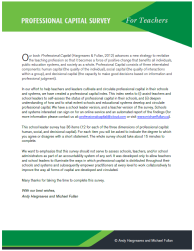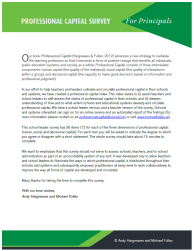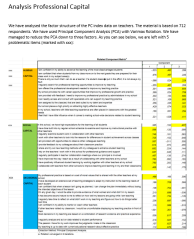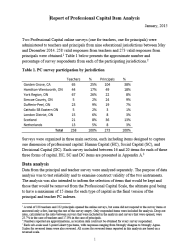Professional Capital Survey
The Professional Capital Survey was originally designed as an online tool to measure dimensions of professional capital in schools. While the online platform and reporting services are no longer in operation, we are pleased to continue sharing:
- The latest versions of the survey (see downloads below)
- General information about its purpose and design
- A short guide on how to use the survey in your own context
- Frequently asked questions to support independent administration
-
General information about its purpose and design
If you choose to use the survey, please note that you will need to handle administration, response collection, and analysis on your own.
We kindly ask that you cite the Professional Capital Survey and the work of Michael Fullan Enterprises when using or referencing it.
General Information
The Professional Capital Survey is grounded in the framework of professional capital, which emphasizes the importance of building strong human capital (the skills and knowledge of individuals), social capital (the quality of relationships and collaboration), and decisional capital (the ability to make sound professional judgments).
The Professional Capital Survey is not designed and should not be used to evaluate schools, teachers, and/or school administrators as part of an accountability system of any sort. It was developed only to allow teachers and school leaders to illuminate the ways in which professional capital is distributed throughout their schools and systems and subsequently empower practitioners at every level to work collaboratively to improve the way all forms of capital are developed and circulated.
Format and Structure
- The survey contains 36 items
- Items are grouped to reflect the three key dimensions of professional capital: human, social, and decisional capital
- Respondents answer using a Likert-type scale (e.g., strongly agree to strongly disagree)
How to Use the Survey
Since the online platform is no longer available, you can administer the survey independently. Here are some suggested steps:
- Download the survey – Use the most recent version provided on this page.
- Choose your administration method – Distribute it electronically (e.g., Google Forms, Microsoft Forms, SurveyMonkey) or on paper, depending on your context.
- Communicate purpose – Let participants know why the survey is being conducted and how the results will be used.
- Collect responses – Decide on a response window and encourage broad participation.
- Analyze results – Look for patterns across groups, strengths, and opportunities for growth. This can be as simple as calculating average scores, identifying trends, or comparing results across time periods.
- Use findings for improvement – Share results with staff or leadership teams to guide professional learning and school improvement strategies.
Download Survey Items Here:
PC Teachers
PC Principals
Factor Analysis Teachers
PC Pilot Report
Frequently Asked Questions
What is the purpose of the Professional Capital Survey?
The survey was designed to assess the degree to which schools are fostering and building professional capital — the combination of human, social, and decisional capital that contributes to effective teaching and learning.
How many items are included in the survey?
The survey contains 36 items (12 items for each of the three dimensions of professional capital: human, social, and decisional capital), designed to capture perceptions across several dimensions of professional capital.
Who can complete the survey?
The survey is intended for educators, school leaders, and other professionals working in education settings. It can be used at the school or district level to gain insight into current practices and areas for growth.
Can Michael Fullan Enterprises administer the survey for us?
No. The online platform and administration service are no longer available. You are welcome to use the survey on your own, but you will need to distribute it, collect responses, and analyze the data independently.
How should we analyze the results?
There is no single prescribed method for analysis. Many users choose to examine response patterns across groups, track changes over time, or connect findings to improvement initiatives. The general information provided here can help guide interpretation.
Can we adapt the survey to suit our context?
Yes, you may adapt the survey for your own use, though we encourage you to maintain the original intent and structure where possible to preserve its value as a research-based tool.
What do online Professional Capital survey reports look like?
The report includes inquiry maps that stimulate educators to reflect on their practices; and an analysis and feedback on Human, Social, and Decisional capital.
How should we cite the survey?
Please reference the Professional Capital Survey and acknowledge Michael Fullan Enterprises in any publications, reports, or presentations that draw upon its use.
What is Professional Capital?
Professional Capital is an essential asset in education — invested, accumulated, and shared to drive continuous growth in both student and adult learning. It is made up of three interrelated components:
-
Human Capital – the talent of individuals. When combined with strong social and decisional capital, high human capital improves schools and enhances the talent of others.
-
Social Capital – the collective capacity of educators to collaborate, share expertise, and continually deepen student learning.
-
Decisional Capital – the ability to make sound professional judgments, improving over time through experience and evidence.
The term Professional Capital was coined by Andy Hargreaves and Michael Fullan in Professional Capital: Transforming Teaching in Every School (Teachers College Press/Ontario Principals’ Council, 2012). It highlights strategies to revitalize the teaching profession as a driver of positive change in education and society.
Does the Professional Capital Index provide valid and reliable measures of Professional Capital?
All survey items were developed following a rigorous process of design and reliability and validity testing.
Content Validity of Professional Capital Index. In the early stages of the development of the Professional Capital Index, an extensive review of existing items related to Human, Social and Decisional Capital was conducted, together with a careful examination of the key dimensions of professional capital presented by Andy Hargreaves’ and Michael Fullan in Professional Capital: Transforming Teaching in Every School. An initial list of 60 items (20 Human Capital items, 20 Social Capital Items, and 20 Decisional Capital items) was produced and shared with over 12 experts to assess the relevance and clarity of the items. Expert feedback was used to gradually narrow down the number of items and enhance their clarity.
Reliability of Professional Capital Index. The professional capital items have been tested for reliability on two separate occasions. Reliability tests have been conducted for each sub-scale (Human Capital, Social Capital, and Decisional Capital) separately. Inter-item correlations between individual items were calculated and Cronbach’s Alpha values were computed and used as a measure of internal consistency – that is, how closely related items in each set were as a group. Inter-item correlations among all items in each subscale are positive. The three sub-scales in both the teacher and principal indexes show Cronbach’s Alpha coefficients higher than 0.7, which suggests high reliability (Conventionally, Cronbach’s Alpha coefficients higher than 0.7 are desirable).
Construct Validity refers to whether the measurements obtained index reflect the meaning of professional capital. The construct validity of the professional capital index has been tested in two major ways. The first the administration of the professional capital survey in two school districts – one with a long trajectory of improved performance and one in the first few years of its improvement journey. Human, social, and decisional capital scores were significantly higher in the high performing district than in the low performing one, suggesting that the index provides valid measures of professional capital. The second construct validity test was a Principal Components Analysis to test the final list of 36 professional capital items. The PCA reveals the existence of three factors capturing three dimensions of professional capital which, overall, correspond to the three sets of items that make the survey: Human Capital, Social Capital, and Decisional Capital.




